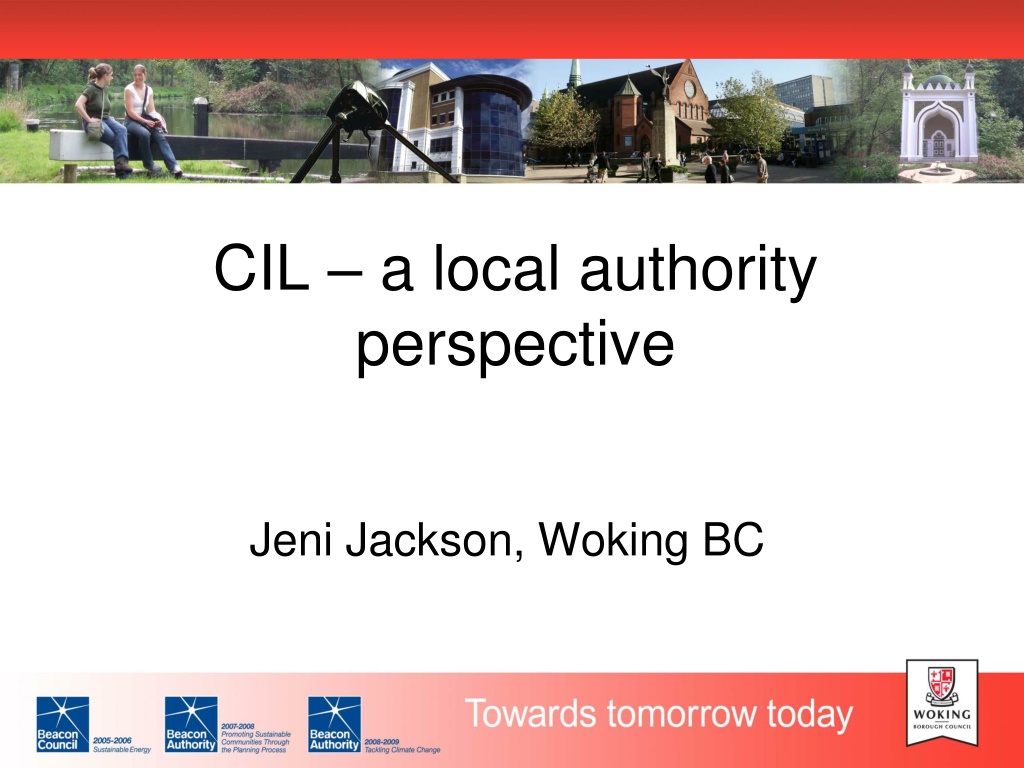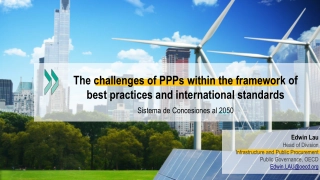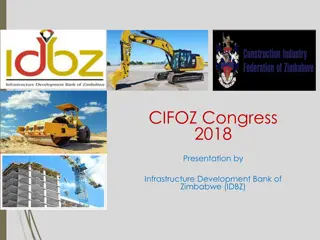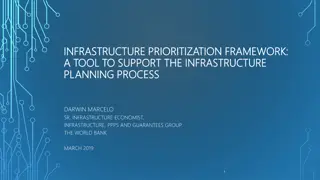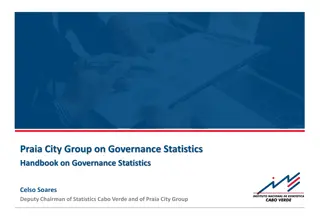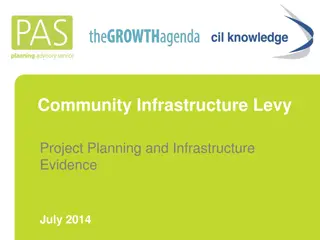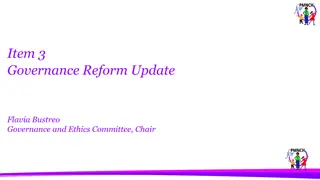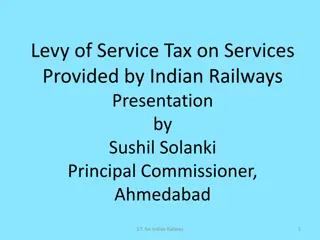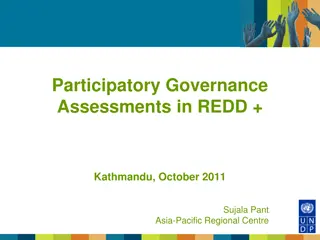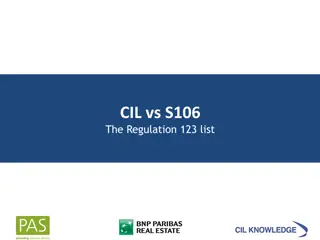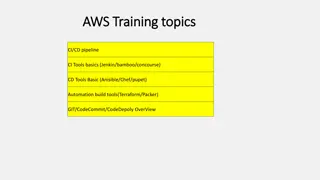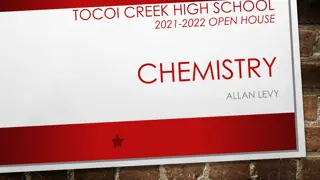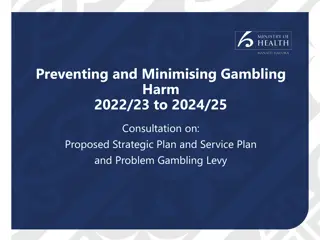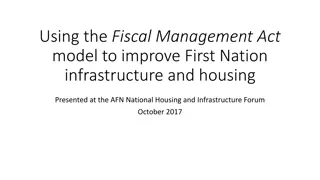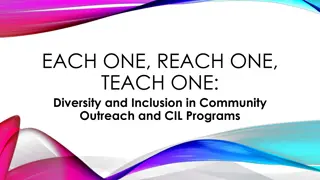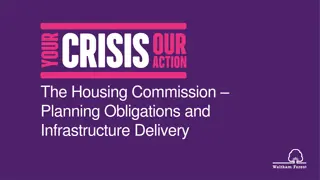Woking's Community Infrastructure Levy (CIL) and Governance
Discover the essential aspects of Woking's Community Infrastructure Levy (CIL), including its local authority perspective, vital statistics, charging schedule, and governance structure. Learn about the core strategy, CIL examination process, implementation timeline, and key regulations governing development support in Woking. Explore insights on governance, political dynamics, and the unique challenges faced in infrastructure planning in Woking.
Download Presentation

Please find below an Image/Link to download the presentation.
The content on the website is provided AS IS for your information and personal use only. It may not be sold, licensed, or shared on other websites without obtaining consent from the author.If you encounter any issues during the download, it is possible that the publisher has removed the file from their server.
You are allowed to download the files provided on this website for personal or commercial use, subject to the condition that they are used lawfully. All files are the property of their respective owners.
The content on the website is provided AS IS for your information and personal use only. It may not be sold, licensed, or shared on other websites without obtaining consent from the author.
E N D
Presentation Transcript
CIL a local authority perspective Jeni Jackson, Woking BC
Woking: Vital Statistics Population 99,198 in 2011 greying population Net importer of workers Need for school places
In Woking Our Core Strategy was the first to be found sound post NPPF We have an Infrastructure Delivery Plan which is informed by the quantum, type and location of development in the CS Consultants conducted our Viability work for us
CIL Charging Schedule Two rates Type of development Residential (Town Centre, Sheerwater and Maybury) Residential (rest of the Borough) Retail (all types) All other commercial and non- residential uses Charging Schedule 75 per square metre 125 per square metre 75 per square metre Nil ( 0 per square metre)
In Woking We submitted our CIL for examination, we didn t have one . No one wanted to appear! We received a report from the Inspector on 9 July 2014 that it was sound Council took a decision to adopt, implementation date 1 April 2015
Why April 2015? The drop dead date in the regulations There is so much to do!
CIL Governance Literature review Other examples in Surrey - Elmbridge Government Frontrunner 2011
CIL Governance Two tier authority Joint Committee
The political bit The role of Members Level of understanding The dichotomy of what is needed to support new development and what Members want . It was ever thus! Regulation 123 list
Wokings Process 1. Planning services planning application 2. Finance/Revs & Bens collection 3. Delivery corporate functions 4. Planning services - monitoring
Infrastructure Working Group Political Members: Portfolio Holder for Planning, WBC WBC Member representative SCC Member representative (the above to include representation from both main political parties also)
Woking IWG Members Head of Planning, Woking BC (Chair) Planning Policy Manager, Woking BC Promoting the Borough Manager, Woking BC Corporate Policy Manager, Woking BC
Surrey CC IWG Members For Surrey CC the following areas would be represented as required: Spatial Planning Transport Policy Infrastructure Agreements School Commissioning Economic Development Property Services
Aim of the IWG To meet the challenge of aligning infrastructure delivery to development coming forward on the back of the Core Strategy, To deliver the infrastructure requirements of the Core Strategy as amplified in the Infrastructure Delivery Plan.
Aim of IWG cont. To facilitate delivery of the schemes identified in the CIL Regulation 123 list. To coordinate with other infrastructure providers including utility companies.
IWG Objectives to provide a co-ordinated and consistent response to delivery of the infrastructure set out in policies of the Core Strategy; to ensure that overarching infrastructure delivery mechanisms are secured; to advise the Joint Committee on the Reg 123 List schemes and their priority, in delivery terms, to ensure maximum benefit to the community
Categories of Infrastructure Category Description Critical Infrastructure that must be provided to enable growth and without it development cannot be allowed to proceed e.g. major utilities infrastructure 1 Essential Infrastructure that is considered essential and necessary to support and/or mitigate the impact arising from development. The timing and phasing of these projects e.g. school places and public transport projects are usually linked to the occupation of development sites. 2 Deliverable Infrastructure that is required to support wider strategic objectives, to build sustainable communities and to make places. This type of infrastructure is influenced more by whether a person chooses to use the facility e.g. community facilities. The timing is not critical and is usually linked to completion of development. 3
Scheme Prioritisation Criteria Be included in the Infrastructure Delivery Plan Be included in the Regulation 123 list Deliver specific policies of the Core Strategy (and, in due course, the delivery DPD) Yes/No Contribute to the delivery of other approved Council strategies, e.g. open space Contribute to the delivery of the Council s Corporate Priorities Contribute towards the delivery of infrastructure by a provider where it can be satisfactorily be demonstrated that the infrastructure would not otherwise be delivered i.e. that all other possible funding sources are insufficient Address a specific impact of new development beyond that which has been secured through a section 106 obligation or a section 278 agreement Lever in other funds that would not otherwise be available e.g. need to match or draw grant funding Offer wider as well as local benefits Be deliverable in the year that the funding is being programmed i.e. justified by (i) a project plan including a timetable and resources available to meet the timetable (ii) consultation summary report to indicate stakeholder support; and (iii) arrangements for ongoing maintenance
The meaningful proportion Woking unlike other Surrey districts has no parishes We have a number of Neighbourhood Fora We have had a ward boundary review Patchwork quilt effect
Going forward Site allocation work in delivery DPD Green Belt & greenfield sites to be allocated 2022 2027 Finding other funding sources
Conclusion Governance to be bespoke Lessons learnt from other LPAs Devil is in the detail Need for corporate cross-working Need to work in partnership at all levels Need to be transparent
